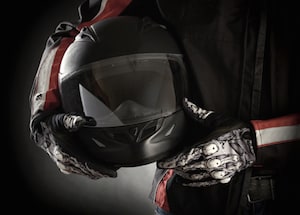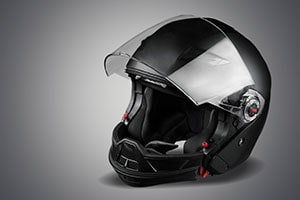
Helmet laws frustrate some motorcyclists in Maryland. It is easy to understand why. But there is a reason for this loss of freedom to choose. World Health Organization tells us that wearing a motorcycle helmet is the single most effective way to reduce the chance of serious injury or death in motorcycle accidents.
The stats do not lie. Wearing a helmet reduces the risk of serious injury by approximately 70%, while the risk of death is reduced by approximately 40%. Not to forget, helmet use decreases the cost of healthcare substantially, meaning that society benefits as a whole from motorcyclists wearing helmets. Countries across the world and most USA states have realized this and figured that passing mandatory helmet laws is a no-brainer (and a brain-saver). Maryland is no exception.
Maryland’s Current Helmet Laws
Section 21-1306 of the Transportation Article of the MD Code requires that all motorcyclists operating a motorcycle wear a helmet that conforms to the standards set out by the Motor Vehicle Administration. Further, eye protection is required unless the motorcycle has a windshield.
The law gives the Administrator of the MVA wide discretion in classifying, approving, and disproving the type of helmets that are permitted to be worn by riders, but also compels him/her to publish a list of the approved helmets for use in Maryland. But, as we discuss later in this article, you should be fine if you wear a helmet that is approved by the Federal Department of Transportation (DOT).
Maryland’s administration regulations, found in COMAR 11.13.05.02, elaborate on this law. This regulation makes clear that the Federal Motor Vehicle Safety Standard (FMVSS) 218, Motorcycle Helmets, 49 CFR §571.218 (1991) is incorporated in the Maryland law as the minimum standard for helmets required to be worn by operators and passengers on motorcycles in accordance with the requirements of Transportation Article, §21-1306, Annotated Code of Maryland.
Believe it or not, it is technically a violation of COMAR to sell, offer for sale, lend, or even borrow a helmet that is not approved by the MVA (once again, DOT-approved helmets are likely fine). It is also a violation to ride around with your chinstrap unfastened because the regulations require that a rider’s chinstrap remain in contact with their chin or jaw whenever the motorcycle is in motion. COMAR 11.13.05.02(F) mandates
F. Chin Strap.
(1) Each approved helmet shall be equipped with either a neck or chin strap and be fastened when the motorcycle is in motion.
(2) The protective headgear shall be worn on the head with chin strap properly fastened, and in contact with the chin or jaw by both operator and passenger at all times that the motorcycle is in motion.
Generally, these same rules apply to those riding motor scooters or mopeds. But the specific law (21-1306.1) requires headgear that conforms to the standards laid out by the federal government as opposed to the MVA. Still, the Administrator has wide discretion to approve or disprove helmets and headgear.
There is also an interesting provision in the law that provides some civil protection to motorcyclists involved in accidents. Specifically, the law prohibits evidence of a rider not wearing a helmet to come in as evidence of negligence, contributory negligence, or diminish their recovery for damages. So there is no “the motorcyclist was not wearing his helmet” defense under Maryland law.
(While we are talking about Maryland motorcycle law, it is also worth keeping in mind that §22-403 of the Transportation Article requires that motorcycles are equipped with two rearview mirrors.)
- Do you need motorcycle insurance in Maryland?
- How to get a motorcycle license in Maryland
A Little History 
The Maryland legislature passed 21-1306 in 1992. Granted, this was not the first time that motorcyclists were required to wear helmets in the state. The 1992 law can trace its origins back to the National Traffic and Motor Vehicle Safety Act of 1966, which set minimum standards for road safety and required states to either meet this minimum or pass regulations that exceeded federal safety standards. Maryland responded by enacting a law requiring the use of a “firm and durable protective helmet” when operating a motorcycle. After tinkering with this law a few times (including only making it applicable to minors), the legislature attempted to create a more concrete method for standardizing the types of helmets that could be worn.
In 1973, the federal government actually helped lay the foundation for Maryland’s law. The DOT put forth requirements that finally standardized the types of helmets that could be worn. They specifically released various performance and testing requirements, which have been amended throughout the years. In 1992, Maryland followed suit and made helmet usage mandatory across the board, while implicitly using federal safety standards as the baseline for approving or disapproving the use of certain helmets in Maryland.
Believe it or not, there was actually a court case that challenged the constitutionality of the helmet law. This case went all the way to the highest court in Maryland. The 1998 case, Ferro v. Lewis, suggested that the law was void because MVA neglected to publish a comprehensible list of approved helmets right off the bat.
In the end, the court said that motorcycle riders could easily glean this information from brochures published by the federal government since Maryland used federal guidelines as a baseline. Granted, the provision requiring the administrator to publish a list of approved helmets was probably in there to ease consumer confusion when selecting a helmet. So this decision did not really help much in that regard.
Riding Today
As a result, the Ferro case essentially allowed the MVA to slack off a bit. It basically said that any DOT-approved helmet is likely to satisfy Maryland law. If it does not, it is unlikely that any rider would be ticketed for wearing a DOT-approved helmet. This being the case, the MVA has basically adopted DOT approval, as the standard for helmets in Maryland. (Check out pages 2-5 in the MVA Motorcycle Operator Manual). Therefore, a DOT-approved helmet is the way to go when purchasing a motorcycle helmet in Maryland.
There is no doubt that helmets can be uncomfortable and even annoying at times. Some riders insist upon not wearing them. But at the end of the day, having that layer of protection between your head and the road can be the difference between life and death. Nobody likes having the government tell them what to do, especially when it involves
commands like wearing a helmet. Then don’t do it because the government says so. Do it so that your family does not call our lawyers asking about a wrongful death lawsuit. The numbers simply do not lie: helmets save lives and generally make the road a safer place for everyone.
- We are Maryland motorcycle accident lawyers who regularly represent victims of motorcycle accidents. The one question victims always have?
- What is the value of my bike accident case?
- Sample demand letter for money compensation after a motorcycle accident
Hiring a Lawyer
If you have been injured in a motorcycle accident case in Maryland, your damages are the same whether or not you were wearing a helmet. What matters is that you were hurt by the negligence of someone else. If you have been hurt or have lost a loved one, call Miller & Zois at 800-553-8082 or get a free online consultation.
 Although all Maryland motorcycle riders are required by law to wear a helmet, some choose to forego helmets and other protective gear. Helmets can’t prevent crashes or injuries entirely.
Although all Maryland motorcycle riders are required by law to wear a helmet, some choose to forego helmets and other protective gear. Helmets can’t prevent crashes or injuries entirely.
But they could make the difference between life and death. On average, 1,400 motorcycle riders are injured, and 70 are killed on Maryland roads each year, with head injuries accounting for a majority of the fatalities.
Some motorcyclists complain that helmets are hot or unwieldy. But the truth is that a well-fitting helmet can actually cut down on wind noise and deflect road debris, making for a more comfortable ride while providing a vital measure of safety.
Most motorcycle crashes occur on short trips and at a speed of less than 30 miles per hour, making it important to wear a helmet on every single ride.
Under these most common accident conditions, wearing a helmet can reduce the number and severity of head injuries by half.
Maryland’s Motorcycle Helmet Laws
Maryland has had universal helmet laws, obligating all motorcycle drivers and passengers to wear an appropriate safety helmet and eyewear at all times, in effect since 1992.
Section 21-1306 of the Maryland Code’s Transportation Article gives the Motor Vehicle Administration (MVA) the power to establish standards for appropriate motorcycle protective gear and requires the administrator to publish a list of all acceptable helmets.
Although the law dictates that this list must include the name and type of each legal helmet, the MVA has never been very diligent about updating the list. Instead, the MVA has accepted Department of Transportation (DOT) standards, making it safe to purchase any helmet or eyewear carrying the DOT certification sticker.
Any motorcyclist in violation of section 21-1306 may be fined, but according to the law, failure to wear a helmet may not be considered evidence of contributory negligence. In other words, if a motorcycle rider is involved in a crash, whether or not she was wearing a helmet will have no impact on the amount of money damages she is allowed to recover.
What Makes a Good Motorcycle Helmet?
All motorcycle helmets sold in the United States must be DOT certified and carry the DOT label, permanently fixed to the back of the helmet so that it is easily visible. Other organizations also judge helmet safety based on their own set of standards.
Helmets with Snell certification, for example, may be even safer than DOT only certified helmets because Snell continuously revises its testing standards as design and technology improve. Each organization uses a variety of procedures to test helmets for impact, penetration, retention, and peripheral vision.
According to DOT standards, helmets must absorb shock, withstand a blow from a sharp object, keep the chin strap fastened without stretching or breaking, and provide a minimum of 105 degrees peripheral vision on each side.
The four basic components of motorcycle helmet construction work together to provide the DOT standard of protection. Combined, these variables provide different degrees of protection and fit and can vary with helmet size, brand, or style.
- Outer Shell – Made out of polycarbonate, thermoplastic, Kevlar, carbon fiber, graphite, fiberglass, or a combination of these materials, the outer shell is designed to be tough enough to withstand flying debris. Yet, it is also designed to compress when it takes an especially hard hit, dispersing energy from the initial blow throughout the absorbing liner to reduce the force of impact before it reaches the rider’s head.
- Impact-Absorbing Liner – Usually composed of a one-inch-thick expanding polystyrene (or Styrofoam) system, the shock-absorbing liner is a cushioning layer. Different helmets are designed to absorb shock in different ways. Some may delaminate on impact, some crack and break, and others appear unharmed even after a hard hit. It is important to replace helmets every few years and after every crash. Why? Because it’s possible for a helmet to look normal even if its protection has been compromised.
- Comfort Padding – The soft layer of foam and cloth sitting next to the wearer’s head is designed for comfort and fit, and in most helmets, it can be taken out for cleaning.
- Retention System – Also known as the chinstrap, the retention system is connected to each side of the shell and is the piece responsible for keeping the helmet on the rider’s head in a crash. In order to work effectively, the strap must be fastened securely.
Many different helmet styles meet the minimum safety qualifications. Full-faced helmets cover the entire face, including the eyes, with a moveable face shield. Three-quarter or open-face helmets are constructed with many of the same components but don’t offer face or chin protection.
Riders using open-face helmets must use a snap-on face shield or a pair of goggles (not tinted) in addition to the helmet. This eyewear must also meet DOT specifications. Shorty or half-helmets are also sold, but they do not provide enough protection or retention for motorcycle riders.
After the minimum DOT qualifications are accounted for, choosing a motorcycle helmet is largely a matter of personal preference. Human heads are shaped differently, and different helmet brands, styles, and sizes will provide varying fit and comfort.
A well-fitted helmet will be less distracting and less likely to come off during a crash, making the proper helmet fit a matter of safety. Using the Motor Safety Foundation‘s tips, find a helmet that fits snugly against the skin without any gaps, and doesn’t cause any soreness or red spots.
MVA Recommendations
Wearing DOT certified helmets and eyewear is a legal necessity for all motorcycle riders, but the MVA requires motorcyclists participating in any of their rider courses to wear additional protective gear. From a legal standpoint, this gear is optional, though it is highly recommended for optimal motorcycle safety.
- Full-Fingered Gloves – Allow for the best-possible grip, even in rainy weather or if the rider’s hands are sweaty. In order to provide acceptable grip and protection, gloves should be full-fingered and made of leather or synthetic
materials. - Long Pants – To meet the minimum rider course requirement, pants must be made of a sturdy material, not baggy or loose fitting. Although standard denim jeans are the most popular riding pants, they are not durable enough for a riding environment. Instead, riders should consider special riding jeans, lined with Kevlar or leather.
- Long-Sleeved Jacket or Shirt – Anything long-sleeved will suffice for a rider course, but the MVA recommends clothing that is designed specifically for motorcycling. Not only will motorcycle-specific gear make for better safety protection, it will also keep riders more comfortable in adverse weather conditions. Leather gear provides the most protection, but it can get uncomfortable in warm weather. Instead, newer textile riding jacket systems are recommended for their superior comfort and versatility. Most include removable thermal layers and a rain liner.
- Over-The-Ankle Shoes or Boots – Footwear with low heels and rubber, non-slip soles are preferable because they provide better grip and comfort on the foot controls.
Contact a Lawyer
If you have been injured in a motorcycle accident in Maryland, your damages are the same whether or not you were wearing a helmet. What matters is that you were hurt by the negligence of someone else. If you have been hurt or have lost a loved one, call Miller & Zois at 800-553-8082 or click here for a free no obligation Internet consultation.
 Maryland Personal Injury Lawyers
Maryland Personal Injury Lawyers





